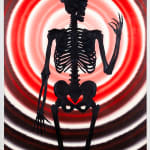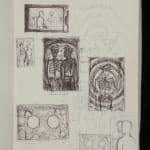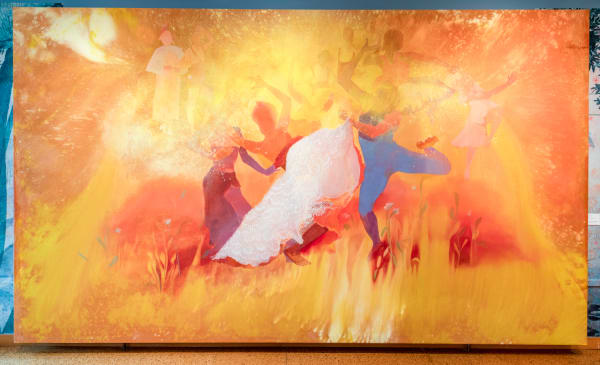274.3 x 487.7 cm
-
Artworks
Roger Brown
Peach Light, 1983Oil on canvas72 x 48 1/2 x 2 in
182.9 x 123.2 x 5.1 cm4849Further images
One of Brown's most iconic paintings, Peach Light was one of many particularly grim, morbid paintings that Brown produced while his partner, George Veronda, was suffering from terminal illness and...One of Brown's most iconic paintings, Peach Light was one of many particularly grim, morbid paintings that Brown produced while his partner, George Veronda, was suffering from terminal illness and in the subsequent years following his death in 1984. Veronda had lung cancer, but he was one of many individuals that Brown knew who had started showing signs of terminal illness in the early 1980s. While the death tolls of the HIV/AIDS crisis wouldn't skyrocket until later in the decade, the infection rate was out of control, with numbers tripling from approximately 30,000 and 100,000 between 1981 and 1982, and tripling again from 100,000 to 300,000 between 1982 and 1984. These numbers disproportionately affected gay men. 1983, the year Peach Light was painted, was a major year in the national conversation about the AIDS crisis: The New York Times publishes its first front-page story on AIDS, the US Public Health Service opened its AIDS hotline, the US government passed its first bill for the funding of AIDS research, and the World Health Organization held its first meeting on the topic of AIDS as an international crisis.
Peach Light, according to scholar Lisa Stone, refers to a trend in gay bars and other LGBT spaces during the HIV/AIDS crisis to tint their lights slightly warmer with pink or peach hues. This lighting choice was meant to help make pale people stricken with the disease at least appear slightly more healthy, a morale boost for a community being devastated by the diseases. Brown's choice of a skeleton as the subject perhaps underscores the morbid reality that these figures illuminated by peach light are, ultimately, facing death despite their best appearances.Provenance
Artist Studio, Chicago
Phyllis Kind Gallery, Chicago
DC Moore Gallery, New York
Roger Brown Study Collection, Chicago
Kavi Gupta, ChicagoExhibitions
2012, Roger Brown: This Boy’s Own Story, Sullivan Galleries, The School of the Art Institute of Chicago, curated by Kate Pollasch, a project of the Roger Brown Study Collection.
2015, Roger Brown: Political Paintings, DC Moore Gallery, New York
2017, Kavi Gupta, Art Basel Miami Beach
2024, Kavi Gupta, Felix Art Fair
Share- X
- Tumblr
Contact: +1 708-480-2882
General Inquiries: info@kavigupta.com
Media Inquiries: media@kavigupta.com
Client & Sales Inquiries: client@kavigupta.com
Publications: Kavi Gupta Editions
Kavi Gupta Washington Blvd
835 W. Washington Blvd. Chicago, IL 60607
Hours | Tue–Fri: 11 am–6 pm, Sat: 12 pm–5 pm
Kavi Gupta Elizabeth St
219 N. Elizabeth St. Chicago, IL 60607
Hours | By appointment only
Kavi Gupta Warehouse
2108 S. California Ave. Chicago, IL 60608
Kavi Gupta New Buffalo
215 E. Buffalo St. #219 New Buffalo, MI 49117
2025 Kavi Gupta
This website uses cookies
This site uses cookies to help make it more useful to you. Please contact us to find out more about our Cookie Policy.












